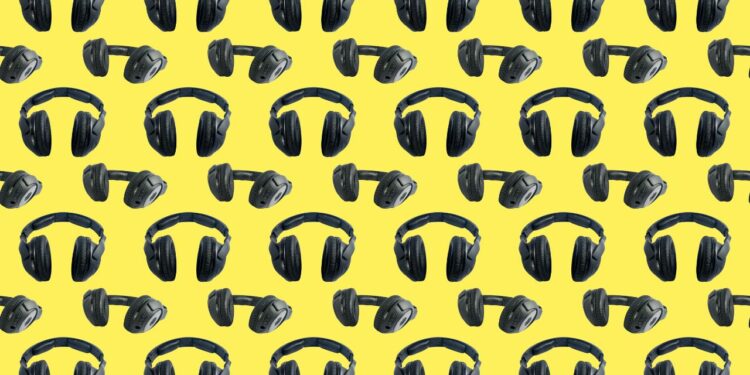- Ziplyfiber analyzed over 11,000 songs from 43 Work From Home playlists on Spotify to determine which songs and artists were featured the most.
- The report found that 29% of the most popular WFH songs on Spotify are also featured in 2022 TikTok trends, and Harry Styles is the most featured artist on 2022 WFH playlists.
- Music can engage your brain when completing repetitive tasks — which helps with worker burnout. Experts say listening to music can lower stress and have therapeutic effects on a range of mental and physical health conditions.
One recent survey from Verywell Mind found that 79% of people turned to music to cope with the stress of the pandemic — many of whom were working from home.
This coping strategy is helpful in more ways than one. Music is proven to make people happy, and happy people are productive people.
Depending on what kind of work you do, music can provide a sense of rhythm. Just as slow and soothing music reduces your heart rate and lowers blood pressure, upbeat music can create a sense of alertness and focus.
Ziplyfiber analyzed over 11,000 songs from 43 Work From Home (WFH) playlists on Spotify that have been updated in 2022 to determine which songs and artists were featured the most.
With Gen Z and Millennials making up nearly half of the U.S. workforce, it’s not surprising that many of the most popular songs for remote workers gained traction from viral TikTok trends.
Some examples include, “Heat Waves,” “Cold Heart – PNAU Remix,” and “As It Was,” which according to new Spotify data are among the most featured tracks on 2022 Work From Home playlists.
The survey found that 29% of the most popular WFH songs are also featured in 2022 TikTok trends.
Harry Styles is the most featured artist on 2022 WFH playlists, and U2 is the only popular WFH artist that isn’t predominantly associated with the pop genre.
Here are the top 14 WFH songs:
- Heat Waves — Glass Animals
- Peaches — Justin Bieber, Daniel Caesar, Giveon
- Beggin’ — Måneskin
- Cold Heart (PNAU Remix) — Elton John, Dua Lipa, PNAU
- Something Just Like This — The Chainsmokers, Coldplay
- STAY — The Kid LAROI, Justin Bieber
- As It Was — Harry Styles
- Feel It Still — Portugal. The Man
- Save Your Tears — The Weeknd
- Watermelon Sugar — Harry Styles
- ily — Surf Mesa, Emilee
- Shape of You — Ed Sheeran
- This City — Sam Fischer
- I Like Me Better — Lauv
Here are the 15 most popular WFH artists:
- Harry Styles
- Taylor Swift
- Beyoncé
- Ed Sheeran
- Rihanna
- Lauv
- Maroon 5
- Billie Eilish
- Katy Perry
- Coldplay
- Justin Bieber
- U2
- John Mayer
- Bruno Mars
- OneRepublic
Listening to music while working can improve wellness
“Many people use listening to music as a tool to improve their mood and focus. It can make you more productive, motivated and happy, which can translate to many benefits in the workplace,” according to Indeed.
Scientifically, music has the ability to engage your brain when completing repetitive tasks — which helps with worker burnout. Music can also lower stress levels.
Music’s positive effects have been comprehensively studied; not only does it entertain the brain, but it can help with healing as well. Experts say listening to music can potentially have therapeutic effects on a range of mental and physical health conditions, according to PsychCentral.
According to a Taylor & Francis journal, listening to music can:
- Release endorphins and improve our sense of well-being
- Lower our heart rate and cortisol levels
- Distract us, which reduces physical and emotional stress levels
- Reduce stress-related symptoms, whether used in a clinical environment or in daily life
Americans who work from home listen to music the most
Given its benefits, it’s no wonder that listening to music while working from home is so popular.
In fact, the average person listens to 18.4 hours of music per week — but the average American spends 26.9 hours per week listening to music.
It’s important to be intentional about the music you play while you work, though, such as not choosing music that is angry. Listening to sad or angry music may have a negative impact on your mood or work performance.


 Dr. Gleb Tsipursky – The Office Whisperer
Dr. Gleb Tsipursky – The Office Whisperer Nirit Cohen – WorkFutures
Nirit Cohen – WorkFutures Angela Howard – Culture Expert
Angela Howard – Culture Expert Drew Jones – Design & Innovation
Drew Jones – Design & Innovation Jonathan Price – CRE & Flex Expert
Jonathan Price – CRE & Flex Expert










